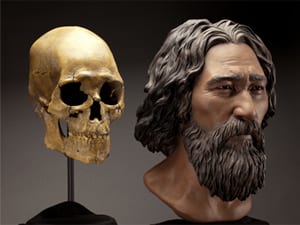Apparently, chewing is just slowing us all down.

Jacqueline Howard, associate science editor for The Huffington Post, covered the research of SMU paleontologist Louis L. Jacobs, a professor in the Roy M. Huffington Department of Earth Sciences, Dedman College of Humanities and Sciences, and paleontologist Anthony Fiorillo, vice president of research and collections and chief curator at the Perot Museum of Nature and Science, Dallas, and an adjunct research professor at SMU.
Jacobs and Fiorillo are co-authors of a study about the identification of new fossils from the oddball creature Desmostylia, discovered in the same waters where the popular “Deadliest Catch” TV show is filmed. The hippo-like creature ate like a vacuum cleaner and is a new genus and species of the only order of marine mammals ever to go extinct — surviving a mere 23 million years.
Desmostylians, every single species combined, lived in an interval between 33 million and 10 million years ago.
Its strange columnar teeth and odd style of eating don’t occur in any other animal, Jacobs said.
The new specimens — from at least four individuals — were recovered from Unalaska, an Aleutian island in the North Pacific.
The authors reported their discovery in a special volume of the international paleobiology journal, Historical Biology. The article published online Oct.1 at http://bit.ly/1PQAHZJ.
The article published Oct. 7, 2015.
EXCERPT:
By Jacqueline Howard
The Huffington Post
Scientists have discovered a previously unknown creature — and it ate in a unique way that hasn’t been seen before.The extinct species, which belonged to a group of aquatic mammals called Desmostylia that lived across the North Pacific some 23 million years ago, hoovered up vegetation like some sort of beastly vacuum cleaner, according to a study published last week in the journal Historical Biology.
“The new animal — when compared to one of a different species from Japan — made us realize that desmos do not chew like any other animal,” Dr. Louis Jacobs, professor of paleontology at Southern Methodist University in Dallas and a co-author of the study, said in a written statement. “They clench their teeth, root up plants and suck them in.”
The researchers concluded that the species, which was dubbed Ounalashkastylus tomidai, might have braced its lower jaw and teeth against the upper jaw and used its powerful muscles to suck up vegetation.
Fossilized bones of the species were recently found on the island of Unalaska in the North Pacific, where the Discovery Channel show “Deadliest Catch” is filmed. The fossils were shipped to the Perot Museum of Nature and Science in Dallas for the researchers to examine — and after taking a close look, the scientists realized the fossils represented a previously unknown animal.
Follow SMUResearch.com on twitter at @smuresearch.
SMU is a nationally ranked private university in Dallas founded 100 years ago. Today, SMU enrolls nearly 11,000 students who benefit from the academic opportunities and international reach of seven degree-granting schools. For more information see www.smu.edu.
SMU has an uplink facility located on campus for live TV, radio, or online interviews. To speak with an SMU expert or book an SMU guest in the studio, call SMU News & Communications at 214-768-7650.


 $3.78 million awarded by Department of Defense to SMU STEM project for minority students
$3.78 million awarded by Department of Defense to SMU STEM project for minority students Kennewick Man: genome sequence of 8,500-year-old skeleton solves scientific controversy
Kennewick Man: genome sequence of 8,500-year-old skeleton solves scientific controversy At peak fertility, women who desire to maintain body attractiveness report they eat less
At peak fertility, women who desire to maintain body attractiveness report they eat less